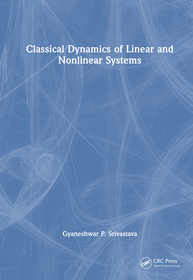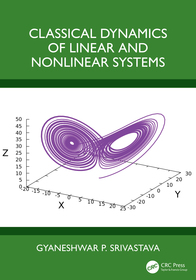
Classical Dynamics of Linear and Nonlinear Systems
-
10% KEDVEZMÉNY?
- A kedvezmény csak az 'Értesítés a kedvenc témákról' hírlevelünk címzettjeinek rendeléseire érvényes.
- Kiadói listaár GBP 165.00
-
78 828 Ft (75 075 Ft + 5% áfa)
Az ár azért becsült, mert a rendelés pillanatában nem lehet pontosan tudni, hogy a beérkezéskor milyen lesz a forint árfolyama az adott termék eredeti devizájához képest. Ha a forint romlana, kissé többet, ha javulna, kissé kevesebbet kell majd fizetnie.
- Kedvezmény(ek) 10% (cc. 7 883 Ft off)
- Kedvezményes ár 70 946 Ft (67 568 Ft + 5% áfa)
Iratkozzon fel most és részesüljön kedvezőbb árainkból!
Feliratkozom
78 828 Ft

Beszerezhetőség
Még nem jelent meg, de rendelhető. A megjelenéstől számított néhány héten belül megérkezik.
Why don't you give exact delivery time?
A beszerzés időigényét az eddigi tapasztalatokra alapozva adjuk meg. Azért becsült, mert a terméket külföldről hozzuk be, így a kiadó kiszolgálásának pillanatnyi gyorsaságától is függ. A megadottnál gyorsabb és lassabb szállítás is elképzelhető, de mindent megteszünk, hogy Ön a lehető leghamarabb jusson hozzá a termékhez.
A termék adatai:
- Kiadás sorszáma 1
- Kiadó CRC Press
- Megjelenés dátuma 2025. december 15.
- ISBN 9781032467931
- Kötéstípus Keménykötés
- Terjedelem326 oldal
- Méret 254x178 mm
- Nyelv angol
- Illusztrációk 138 Illustrations, black & white; 8 Halftones, black & white; 130 Line drawings, black & white 700
Kategóriák
Rövid leírás:
Classical Dynamics of Linear and Nonlinear Systems
TöbbHosszú leírás:
Classical Dynamics of Linear and Nonlinear Systems offers a comprehensive exploration of dynamical systems from fundamental principles to advanced applications. This textbook presents a unified treatment of classical dynamics, bridging the gap between linear and nonlinear systems while providing both theoretical foundations and practical applications.
Beginning with a thoughtful classification of dynamical systems, the book systematically builds understanding from particle mechanics to quantum field theory. Following a rigorous analysis of particle dynamics in both configuration and phase spaces (Newtonian, Lagrangian, Hamiltonian and Hamilton-Jacobi formulations), the book provides a detailed examination of molecular and crystalline structures across multiple dimensions. Later chapters conduct an in-depth exploration of nonlinear phenomena and chaos theory with real-world applications and elegant formulations of classical field theories using Lagrangian and Hamiltonian approaches. The final sections of the book provide an accessible introduction to quantum field theory and its relationship to classical systems, in addition to powerful perturbation techniques applicable to both classical and quantum problems. This book transforms abstract theoretical concepts into practical understanding through rigorous mathematical and numerical frameworks and illuminating examples, making it ideally suited for advanced undergraduate and postgraduate students enrolled in physics, applied mathematics, engineering and materials science courses.
Key Features:
- Connects traditional mechanical concepts with modern physics.
- Includes several worked examples, in addition to end-of-chapter problems and further reading to support teaching and learning.
- Features seven appendices covering further topics such as mathematical preliminaries, numerical solutions to first-order and second-order differential equations and the Euler-Lagrange variational principle.
Gyaneshwar P. Srivastava is Emeritus Professor of Theoretical Condensed Matter Physics at Exeter University, UK. In a teaching career of over 45 years he has taught several physics modules, including analytical and chaotic dynamics. His research has concentrated on theoretical and computational studies of the physics of phonons and electrons in crystalline solids, surfaces and nanostructures. He has collaborated with various physicists, both experimentalists and theorists, of international reputation. This has led to over 500 publications, including several review articles and three postgraduate books. He is an Outstanding Referee for APS journals.
This is a welcome revision, about 30 years after the first edition, of one of the most comprehensive monographs on the theory of phonons. The author has made considerable contributions to research in many of the areas he describes. As well as introducting new topics, the updated edition covers new methods or improved techniques for the calculations covered in the first edition.
The groundwork is established in the first two chapters, covering the elements of crystal symmetry and the reciprocal lattice and the simeclassical treatment of lattice dynamics moving from one to three dimensions, considering simples models of interatomic forces, and discussing lattice specific heat. This is followed by three comprehensive chapters on the ab initio calculation of phonos in the harmonic approximation, including both direct and linear response methods, anharmonicity, and lattice thermal conductivity, including relaxation-time, variational and linear response methods. Chapter 6 discusses the mechanism of phonon scattering from imperfections, through anharmonic processes (including their ab initio treatment), and from interactions with electrons and magnetic impurities in semiconductors. The following chapter brings all of this together in the context of thermal conductivity, again progressing from simple phenomenological approaches to the latest quantitatively reliable calculations. The methods are illustrated with applications to a variety of bulk materials.
The remaining seven chapters cover more specialised aspects of phonons. Some of these are for special geometries, such as surfaces, for special structures, such as layered cyrstal and nanocomposites, or for disordered materials such as impure and mixed crystal and quasi-crystalline and amorphous solids. The remaining topics are topological nanophononics and chiral phononics, phonon spectroscopy, and phonons in liquid helium.
The approach throughout is theoretical and rigorous. The extensive references include work up to 2021, and updated appendices bring the material on ab initio calculations up to date. The index has been completely revised for this edition, and in some parts is less helpful than that of the first edition. Although the revision is only 13 pages longer than the original, the larger page format and reduced size of figures have allowed a lot more material to be included. This is an excellent monograph, worthy of a place on the shelf of anybody working on phonons.
- A.H. Harker, Physics and Astronomy, UCL (reitred).
TöbbTartalomjegyzék:
SECTION I General considerations
Chapter 1 Classification of Dynamics and Scope of This Book
SECTION II Linear dynamics of particles and objects
Chapter 2 Dynamics of Particles and Objects in Configuration Space
Chapter 3 Dynamics of Particles and Objects in Phase Space
SECTION III Linear dynamics of interacting particles
Chapter 4 Dynamics of Linear Molecules and Linear Atomic Chains
Chapter 5 Dynamics of Two- and Three-Dimensional Crystals
SECTION IV Nonlinear dynamics
Chapter 6 Non-linear Motion and Chaos ? Theory
Chapter 7 Non-linear Motion and Chaos ? Applications
SECTION V Elements of classical field theory
Chapter 8 Lagrangian and Hamiltonian of a Classical Field
SECTION VI Beyond classical mechanics
Chapter 9 Elements of Quantum Field Theory
Chapter 10 Classical and Quantum Perturbation Theories
Több







